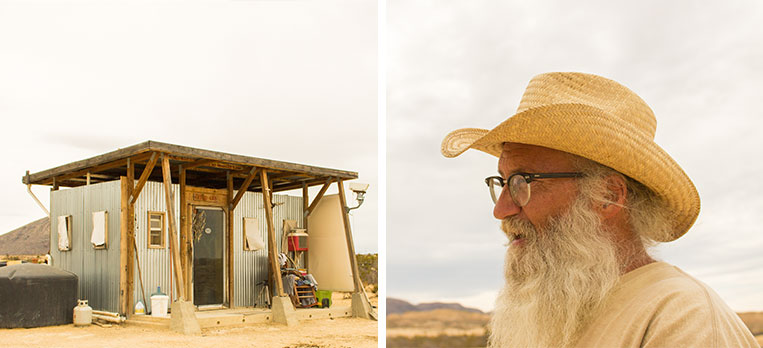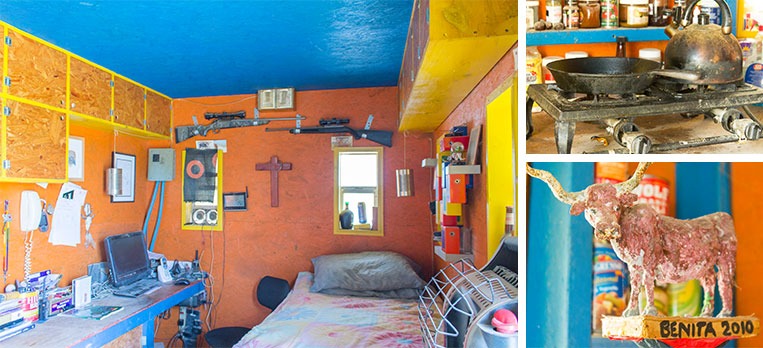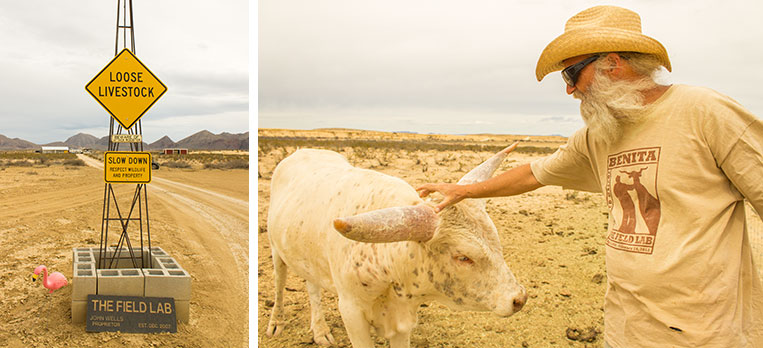
Many tiny house enthusiasts want to get off the grid, and design their homes to run on solar power and catch rainwater. Living off the grid in a rural area has a special romance to it – be independent, financially free, and escape the rat race! It’s natural to romanticize the idea of getting away from it all, but will you like what you get away to?
John Wells wanted to use his time and talents to create his shelter and food directly, instead of using them to make money to pay for food and shelter. He got away in a big way, moving to the Texas desert and building an off-grid, 128 square foot home. When he spends much of his time tending his cattle and greenhouse garden, and exploring or working on the land, why build a big house? This life wouldn’t work for everyone, but with his endless curiosity and impressive work ethic, it suits John just fine.
“I Was Ready For Something Different”
John and “the Field Lab” may look familiar from Lloyd Kahn’s “Tiny Homes, Simple Shelter”, his 2011 New York Times Profile, and coverage on popular blogs from Apartment Therapy to Boingboing. There’s plenty to read if you’re curious about him: he’s also been writing daily and chronicling his experience for seven years. I visited John to learn what kind of attitudes and aptitudes made his new life possible, and make it preferable to the life he left behind.
John worked in New York City as a photographer and prop builder until he tired of New York’s pace and crowds, then lived in a large house in upstate New York until he felt consumed by bills, taxes and debt. He rented his house to summer vacationers to make extra money, while he lived in a travel trailer in his yard. This eased his transition into a totally different approach to life: minimizing the cost of his house and land, and minimizing his stress and debt along with it.
John eventually bought land in Southwest Texas so cheap that he felt he could safely back out if his off-grid experiment didn’t agree with him. He’s frank about the challenges of the area, like frighteningly intense storms and the lack of good paying work. This life works for John because his days now are filled with what he really likes to do: independently pursue a broad range of interests that provide tangible results. The line between his work and play can be hazy, upcoming “projects” include taking powered paragliding lessons, trying to grow coconuts, and building a solar-powered water pasteurizer to filter the water he catches on the roof of his greenhouse and make it safe to drink.
These are abridged and edited highlights of my conversation with John, but you can learn more about why off-grid, tiny home living works for him in my ebook Life in a Tiny House.

On the transition from his big house in New York to his tiny house in Texas:
John: I figured if I could rent my [New York] house in the summer, that would help pay some of the bills. That was sort of my last ditch effort to stay. After living in an Avion travel trailer two summers in a row, I discovered it was really nice to live that way. I was living in about the same-sized space that I have here. At the end of the summer when the renters would leave, and it was time for me to go back to the big house, it was like, “I kinda want to just stay out here.”
I started digging online a little bit more about this area, and all of a sudden I just decided, “I gotta sell my house. I can’t afford this house anymore.” It was 2,800 square feet, 35 acres in upstate New York. My property taxes alone were $1,000 dollars a month, and the mortgage on top of that, heating oil, and all the bills…My nut was like $4,500 a month up there.
My monthly expenses here are like $200, and everything’s paid for – no mortgage. Now I don’t have to think about my bills when I get up in the morning, which is a really nice feeling.

On why he wanted to live off the grid:
John: It wasn’t environmental. I don’t consider myself a “prepper,” either. I didn’t come out to get away from government. I just… I’d read a book that was a compilation of letters that a great, great, great grandmother had written, that were turned into a book by a historical society. It was when she left Baltimore and went to the Ohio frontier somewhere. I read the whole book, and it was so intriguing to read about the frontier life – creating it all on your own, and leaving the city life behind. It was a year or two before I even thought about leaving upstate New York and coming out to do this, but it occurred to me that that seemed like an interesting lifestyle, to just provide everything for yourself.
Once I went freelance, it’s like I just took over that work ethic of always being involved and busy in what I’m doing. You’re not just punching a time clock for somebody else, and they’re basically making it happen. You gotta make it happen when it’s your gig.
Hear more of John’s story in his own words at thefieldlab.org, or visit his daily blog to see what’s new at the Field Lab.

Comments are closed.